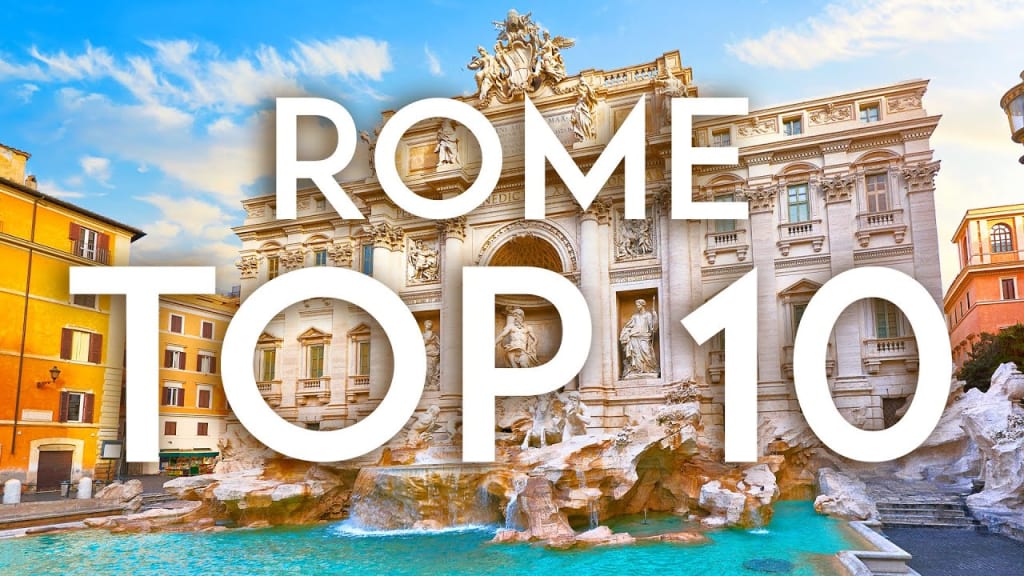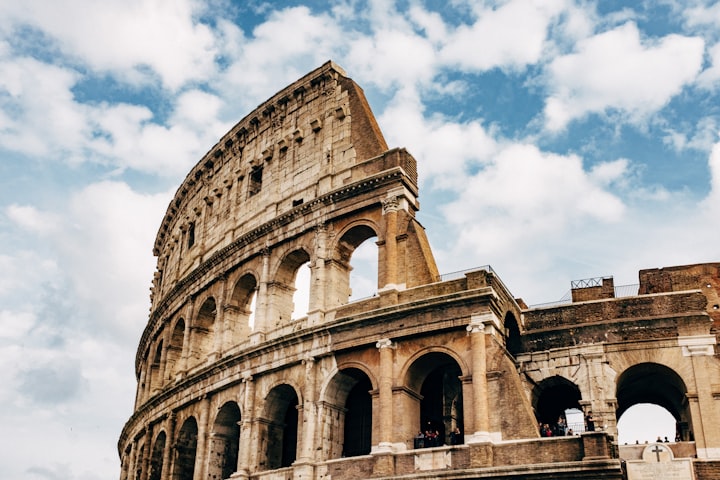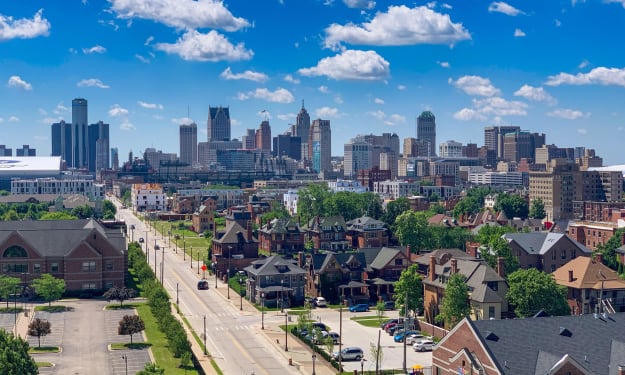TOP 10 Things to do in ROME - [2023 Travel Guide]
Welcome to our comprehensive travel guide for Rome in 2023! In this video, we'll take you on a virtual tour of the top 10 must-visit attractions and experiences in the Eternal City. Rome, with its rich history, iconic landmarks, and vibrant culture, offers a captivating blend of ancient ruins and modern delights. Join us as we explore the enchanting streets, indulge in mouthwatering cuisine, and immerse ourselves in the timeless charm of this magnificent city.

In this post , we'll show you the ten best things to do in Rome. The suggestions are based on our countless trips to this historic city. This post is sponsored by Beeyond, the maker of popular compression packing cubes, a revolutionary new way to organize your luggage and save space. The link is in the description. Don't forget to like this post , subscribe to our channel, and enable notifications. And share your own experience in the comments below. And stick around until the end because we have a bonus attraction that might surprise you.
Top 10 things to do in Rome ⭐ Sponsored by BEEYOND packing cubes, a revolutionary new way to pack your luggage 🧳 🎒 👉 https://amzn.to/43uwwz0 👈 (on Amazon)
🔥📚 Rome PDF Guide 👉 https://amzn.to/3qB2U47 🔥
Here are our top 10 picks:
NUMBER 10: Roman Forum & Palatine Hill The Roman Forum developed gradually over many centuries from what was a swampy lake collecting water from the surrounding hills. The forum was the center of public life in ancient Rome. Located next to the Colosseum and surrounded by government facilities and other important buildings – it was the venue of major public events such as elections, criminal trials, processions, or public speeches. We all probably heard about the legend that says Rome was founded by Romulus, who killed his twin brother Remus after the two of them have been raised by a she-wolf. Romulus is supposed to be buried under the Roman Forum. After the fall of the Empire, the Forum was neglected. It was used as a meadow for livestock and got the nickname Campo Vaccino, meaning Cow Field. The site was first excavated in the 18th century and is now an enormous open-air museum featuring relatively well-preserved ruins of old buildings. If you don't have time to visit the area, you can see a big part of the forum from the public street above. Don’t skip Foro di Traiano and other interesting buildings just across the street. Located above Roman Forum, you will find Palatine Hill, one of the seven hills of ancient Rome. The settlements on Palatine Hill date back as far as the 10th century BC. Today you can visit an impressive collection of archaeological sites from different eras of ancient Rome. According to a legend, the she-wolf that took care of Romulus and Remus lived here. Don't skip impressive views of the entire Roman Forum from terrace on Palatine Hill.

NUMBER 9: Colosseum Located right next to the Roman Forum, you will find Colosseum – the largest amphitheater ever built. Construction of this remarkable structure was completed in the year 80 and was made using stone and concrete to demonstrate Roman building techniques to the entire world. The amphitheater was a gift to the people of Rome by the Flavian Dynasty to gain their popularity. In fact, for that reason, the emperors organized significant events in the Colosseum, and they were free to attend, and sometimes even free food for the visitors was provided. Colosseum was used for gladiatorial combats, animal hunts, executions, re-enactments of famous battles, as a stage for theatrical performances, and other public spectacles. While the structure still stands earthquakes damaged it over the years.

NUMBER 8: Altare Della Patria Altar of the Fatherland or Altare Della Patria in Italian is a large monument built on top of a part of Capitoline Hill. The monument was built in honor of the first king of unified Italy, Victor Emanuel II, and is, to this day, actually the largest monument in Rome. The construction began in 1885, but the monument was not completed for another 50 years. The construction of Il Vittoriano, as it is also called, was controversial because it included destroying a large part of Capitoline Hill's Medieval neighborhood. You can climb the monument, see the tomb of the unknown soldier, visit the museum of Italian Unification, and complete your tour by visiting an impressive terrace with amazing views of Rome.

NUMBER 7: Villa Borghese Gardens Villa Borghese is a large public park comprising several buildings, villas, museums, a zoo, and other attractions. The park is located close above Piazza Del Popolo, one of Rome's main squares. The garden was created in 1605 from a former vineyard. In the 19th century, the park was designed to its current form and was purchased by the city of Rome for public use. Terrazza del Pincio, located at the south of the park, offers one of the best panoramic views of Rome. Villa Borghese offers an array of activities: you can rent a boat on one of the lakes in the park and row around the inspiring Temple of Asclepius, visit the Waterclock at Pincio, or stop at one of the open-air restaurants and cafes. Terrazza Viale del Belvedere, situated close to Casina Valadier, offers another beautiful view of the city. Don't skip other impressive gardens and parks in Rome. Check our travel guide for more suggestions. BTW, our mobile-friendly travel guide covers the top 20 things to do in Rome and things to know before you visit, including maps, opening hours, links to buy tickets, itinerary suggestions, and other information. By purchasing our travel guide, you are also helping us sustain this channel, so a big thank you for that!

NUMBER 6: Piazza Navona and the underground ruins of the Circus Agonalis Piazza Navona is a Baroque square from the late 15th century that features several impressive statues and fountains from Baroque architecture. The square was built in the 1st century on a former Dominitian's stadium, now, the ruins are a part of the Unesco World Heritage. The stadium was used for athletics competitions known as "Circus Agonalis" or the competition arena. You can still recognize the square's unique shape and visit the ruins of the stadium 4.5 meters (15 ft.) under Piazza Navona. Later in history, the square turned into a lake during the summer to stage famous naval battles. There are even some legends about ghosts who wander around the square.

NUMBER 5: Trevi Fountain and underground labyrinths Stretching 86 feet or 26 meters in the air, Trevi Fountain is one of the most famous fountains in the world. The fountain was built on the façade of a palace in 1751. The water for the fountain was delivered from Acuqa Vergine, one of Rome's aqueducts, and was considered the purest water you can drink in Rome. The legend says that whoever drinks the water from the fountain or throws a coin in it will return to Rome. By the way, nearly 700,000 euros worth of coins are tossed into Trevi Fountain each year. Don't skip the remains of a Roman house and aqueduct. Vicus Caprarius located just around the corner of the Trevi Fountain, is a system of underground labyrinths from the Roman Times, offering insight into ancient Rome's life, engineering, and ingenuity. It was a part of the complex Virgin Aqueduct that supplied potable water to the city, including Trevi Fountain.

NUMBER 4: Spanish Steps Spanish Steps are a colossal stairway of 135 steps connecting the Spanish Embassy with the Trinità dei Monti church. The steps were built in the 18th century by a French diplomat and took only two years to complete. As the widest stairway in Europe, Spanish Steps quickly gained recognition and eventually became one of the main Roman attractions. According to the tradition, sometime during the spring, part of the steps are decorated with flowers, making an extraordinary sight. At the bottom of the Spanish Steps, there is Piazza di Spagna with the famous Fontana della Barcaccia, dating back to the early Baroque period. Check our Rome 4K walking tour with closed captions to get the full experience, including bohemian Trastevere, and other major sights and hidden gems. The link is in the description https://amzn.to/43uwwz0

NUMBER 3: Pantheon Pantheon is a former Roman temple constructed in the second century AD by the Roman Emperor Hadrian. In 609, Pantheon was given to the pope and was converted into a church. Pantheon is the best-preserved ancient Roman monument. Its impressive concrete dome features an oculus in the center which serves as the primary source of natural light. Since there is no glass covering the oculus when it rains, the floor gets wet. Still, because of an ingenious system of 22 well-hidden holes, the water quickly drains away.
NUMBER 2: Baths of Caracalla Bathing was a part of daily activities in Roman culture, and baths were the central part of Roman urban architecture. The impressive and vast complex of the Baths of Caracalla, which is now only the ruins, was built between 212 and 216 by the Roman Emperor Caracalla to gain popularity. People of different social classes came to the baths every day, not only to bathe but also to socialize. The Baths of Caracalla even featured an entire public library. However, the baths also hide a darker side. In the underground tunnels, hundreds of slaves worked in extreme heat to keep the water warm all the time. If you like ancient public baths, don’t skip Baths of Diocletian. This video is sponsored by Beeyond, helping you save space and organize your suitcase. A revolutionary new way to organize your luggage consists of a set of small and large packing cubes. Once you’re done packing, just compress the air out of your packing cubes like this, and voila, your clothes are compressed and your luggage is organized. We use Beeyond packing cubes on our travels, and they are even designed to fit your carry-on. Visit Beeyond’s Amazon page to get your own compression packing cube set. The link is in the description https://amzn.to/43uwwz0
NUMBER 1: Vatican City Covering an area of 110 acres (44 ha) and with only about 1,000 inhabitants, Vatican City is the smallest state in the world by both area and population. The official name is Vatican City State, and it has been the pope's residence since the year 1377. While the central area is closed to the public, there are many attractions to see, for example, St. Peter's Square and Basilica which are impressive examples of Renaissance architecture. Visit Vatican Museums, displaying a collection of 20,000 works of art. Don't skip Sistine Chapel and one of the most famous frescos in the world, The Creation of Adam, painted in the 16th century by Michelangelo. And here is the bonus that we promised: Did you know that Rome has its own pyramid dating back 2000 years? During the city's rich and diverse history, Romans constantly explored new places to bury their dignitaries. As a result, Rome is also full of mausoleums and crypts worth exploring, such as The Pyramid of Cestius, an ancient pyramid built around 18–12 BCm a tomb for Gaius Cestius. Did you know that Rome actually had two pyramids build as tombs? Meta Romuli was also build in the 1st century was demolished by the 16th century. Castle Sant'Angelo, Hadrian Mausoleum that was later used by popes and as a fortress and a castle. Mausoleum of Augustus, and others. And did you know that there is an area just outside the city center called Appia Antica Park or Appian Way Regional Park with the 2,300-year-old Via Appia road? Here you can find several of the underground burial grounds - Roman catacombs. While there are over sixty catacombs in Rome, with over 180 miles or 300 km of underground passageways, only some are open to the public. Continue to our video on what you should know before you visit Rome.

About the Creator
Enjoyed the story? Support the Creator.
Subscribe for free to receive all their stories in your feed. You could also pledge your support or give them a one-off tip, letting them know you appreciate their work.






Comments
There are no comments for this story
Be the first to respond and start the conversation.